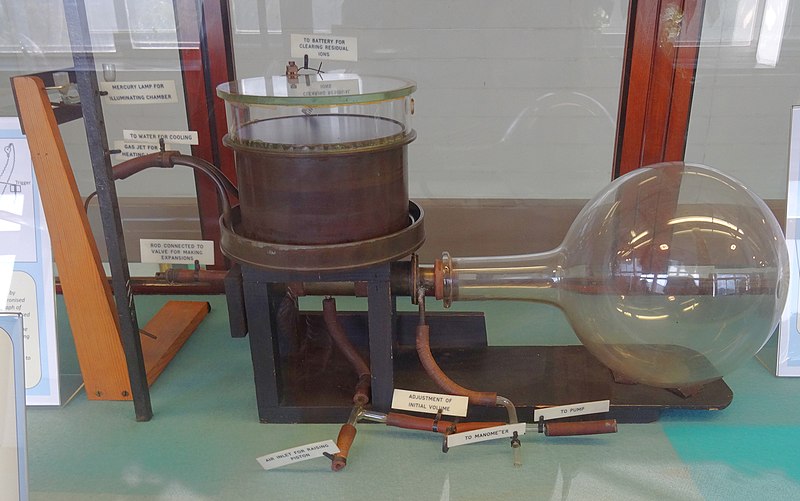Facts for Kids
A cloud chamber, also known as a Wilson chamber, is a particle detector used for visualizing the passage of ionizing radiation.
Overview
Types Of Cloud Chambers
How A Cloud Chamber Works
History Of The Cloud Chamber
Applications Of Cloud Chambers
Cloud Chambers In Educational Settings
Notable Experiments Using Cloud Chambers
Comparisons With Other Particle Detectors
Future Developments In Cloud Chamber Technology
Famous Scientists Associated With Cloud Chambers

Inside this Article
Particle Physics
Cosmic Rays
Antimatter
Technology
Rochester
Particle
Universe
Bubbles
Liquid
Are
Did you know?
🌌 A cloud chamber is a special tool that helps us see tiny particles that we can't see with our eyes.
🔭 The first cloud chamber was invented in 1911 by a scientist named Charles Wilson.
🌈 Charles Wilson won the Nobel Prize in Physics in 1927 for his work on the cloud chamber.
❄️ Cloud chambers contain gas and are kept very cold to create particle trails.
☁️ When charged particles pass through, they create tiny droplets that look like little clouds.
🌪️ There are different types of cloud chambers, including simple and expansion cloud chambers.
🌌 Cloud chambers help scientists study cosmic rays, which come from outer space!
🏫 Cloud chambers are great for classrooms, helping students learn about particles in real-time.
🔬 Compared to other detectors, cloud chambers are unique because they visually show the particles in action.
🚀 Scientists are working on making cloud chambers even better to find smaller particles and learn more about our universe!
Introduction
It helps us understand things we can't see with our eyes. When charged particles, like protons from space, move through the chamber, they create trails like little clouds. The first cloud chamber was invented in 1911 by a scientist named Charles Wilson. This neat invention has helped scientists discover many things about the universe! 🔭
Types Of Cloud Chambers
️ The simple cloud chamber makes trails visible when particles pass through. The expansion cloud chamber works by changing the pressure inside, helping to create more defined tracks. There’s also the cosmic ray detector, which is a cloud chamber designed specifically for studying cosmic rays from outer space! ☄
️ Each type has different uses, but they all help us understand particles better!
How A Cloud Chamber Works
️ When charged particles pass through, they hit the gas and ionize it, meaning they knock electrons off atoms. This creates tiny droplets of liquid that look like little clouds! ☁
️ The trails left behind by these droplets show scientists where the particles have gone. The design usually has a clear top, allowing people to see the trails easily. With this amazing tool, scientists learn more about atoms, radiation, and our universe! 🧪
History Of The Cloud Chamber
Wilson was awarded the Nobel Prize in Physics in 1927 for his work! His invention helped scientists learn about cosmic rays and other particles. Over the years, many scientists improved cloud chambers, making them easier to use. Today, researchers around the world continue to use cloud chambers in exciting experiments! 🚀
Applications Of Cloud Chambers
They also help in educational settings, allowing students to see the effects of radiation in real-time! Many researchers study how particles behave in different conditions, which can help us understand the universe better! 🌍
Cloud chambers are even used in particle physics experiments to discover new particles and learn about their properties!
Cloud Chambers In Educational Settings
Teachers can demonstrate particle physics and show students how invisible particles can create visible trails. When students see the clouds, they become excited about science and learn about atoms, electrons, and radiation! 🌈
Many schools and science museums use cloud chambers to inspire young minds and spark their curiosity about the universe. With hands-on experiments, students can become mini-scientists and explore the wonders of particle physics together!
Notable Experiments Using Cloud Chambers
This discovery was crucial for understanding antimatter. Another significant experiment was conducted in 1956, when scientists used cloud chambers to spot neutrinos, tiny particles that help explain many mysteries in physics! 🔍
Cloud chambers continue to be used in experiments all around the world to find new particles and test different theories!
Comparisons With Other Particle Detectors
Another popular type is the bubble chamber, which works similarly but uses liquid instead of gas to create bubbles. Cloud chambers are typically easier to set up and visualize, while bubble chambers can detect more types of particles. 🌀
Some detectors, like the Geiger-Müller counter, measure radiation without visualizing it. Each detector has its strengths and uses, but cloud chambers are unique because they show the beauty of particles in action! 🌟
Future Developments In Cloud Chamber Technology
New technology might allow cloud chambers to detect even smaller particles! There is also research into using cloud chambers in various environments, including outer space, to study cosmic rays better. 🚀
As technology improves, we may discover new ways to visualize particles and learn more about the mysteries of the universe! Children today could grow up to create the next generation of cloud chambers!
Famous Scientists Associated With Cloud Chambers
Besides Charles Wilson, notable physicist Carl D. Anderson discovered the positron using a cloud chamber in 1932. He won a Nobel Prize for his groundbreaking work! ✨
Another important figure is George Rochester, who used cloud chambers to study mesons, a type of particle. These scientists showed how powerful cloud chambers can be in revealing the secrets of the universe! 🌌
Today, many researchers continue to build on their work to expand our knowledge of particles!

